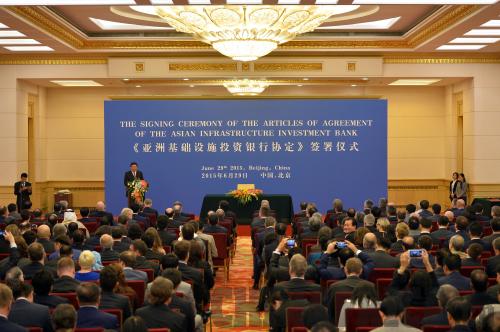| 
The AIIB has a largely emerging market membership
Unsatisfactory reforms of institutions such as the World Bank (WB), the International Monetary Fund (IMF) and the Asian Development Bank (ADB), despite the rising contribution of new players in the global economy and financial architecture, have led to China taking matters into its own hands. Hannah Edinger, a director at Frontier Advisory, a South Africa-based investment advisor, looks at the operationalization of two multilateral development banks, the Asian Infrastructure Investment Bank (AIIB) and New Development Bank (NDB), and the benefits they may have for Africa. Her thoughts follow:
China boasts the position of the world's largest economy (after overtaking the United States in 2014, according to the IMF) and is an important, if not the largest, commercial partner for many other economies in trade, investment and financing terms. Yet, its and other emerging markets' growing importance in the global economic make-up has not been reflected in the decision-making of these global financial institutions - something that is often seen as a disadvantage to emerging and less-developed markets.
Instead of waiting around for things to change, China has been flexing its geo-political and financial muscles, and challenging the current system by creating its own platform. In fact, China is operationalizing not one, but two multilateral development banks - both headquartered in China and both able to draw on China's infrastructure and development experience.
One of the two new banks is the NDB - the first institution launched by the five BRICS (Brazil, Russia, India, China and South Africa) countries. The sidelines of the Seventh BRICS Summit in Ufa, Russia in July saw the inaugural meeting of the NDB's board of governors. The leadership team will be charting the way for operationalizing the bank in the coming months in Shanghai.
Each member country will have a 20-percent share in the bank, and none will have veto power. As a purely emerging market-owned bank, the NDB will be financing infrastructure and sustainable development projects in the BRICS countries, as well as their broader regional economies. The establishment of an African regional center of the bank in Johannesburg signposts the opportunity for African economies to directly benefit from this institution's infrastructure financing.
The second institution, the AIIB, has a much more diverse, yet still largely emerging market membership. Based in Beijing, this Chinese brainchild has seen a far-reaching membership interest. At last count 57 founding countries, including all the other BRICS counterparts, as well as a number of "developed" nations, such as the United Kingdom, Germany, Australia and the Republic of Korea, have signed up.
In June, 50 founding members signed the Articles of Agreement to operationalize the bank. This makes the AIIB not only representative, but also shows the buy-in of countries outside Asia into China's rise as a player to be reckoned with in the global economy. With Asian and other emerging economies expected to contribute about 75 percent of the capital, one of the key differences between the NDB and the AIIB is that of shareholding and voting structures. China is expected to have a 26-percent share of voting rights in the latter, being the largest shareholder at 30 percent, based on GDP size. India and Russia are in second and third position respectively.
Another key difference is that the AIIB will prioritize the Asian region as its lending playground of choice. This is based on its mandate to "promote interconnectivity and economic integration" in Asia. In fact, the bank is expected to be the financing agent of China's "One Belt, One Road" Initiative, Beijing's long-term grand vision of reinvigorating the Silk Route. The route connects more than 60 countries in the greater Eurasia and Middle East region, pushing Beijing's own agenda that looks to promote deeper financial and economic integration closer to home.
As the fastest-growing region in the world, developing Asia presents plenty of opportunities right on China's doorstep. By investing in and developing infrastructure in mostly lower and middle-income countries, China will help spur sustainable growth levels of the region by crowding in other investment, which will also have positive spillovers for Beijing. The AIIB will supplement efforts of the WB and the ADB in plugging what is estimated to be an infrastructure financing gap of $750 billion to $800 billion per annum - about eight times more per year than that of Africa.
This helps China rekindle ties closer to home, boost its legitimacy as a global lender (especially when lending to projects or sectors deemed taboo or too risky by traditional institutions), create new export markets for its firms, skills and products, and boost its soft power by charming its neighbors.
While the AIIB has no African mandate, there could be certain spillovers for the continent and other emerging markets. This includes a changing development finance and investment landscape generally, with more diverse sources of finance beyond the current status quo.
It also brings a new perspective to development finance, with two emerging market-led banks that are more attuned to the challenges, needs and risks of the countries they operate in and lend to. Both banks should strive toward less red tape, lower financing costs and focus on much-needed infrastructure for emerging and developing markets in general.
Even if no direct or limited benefits come from the AIIB and the NDB respectively for Africa, there will certainly be indirect ones. Increased lending activities and more widespread use of China's currency as a result, together with more open Chinese financial markets and cheaper access to capital, would all benefit Africa indirectly, given the continent's strong commercial links with China.
|